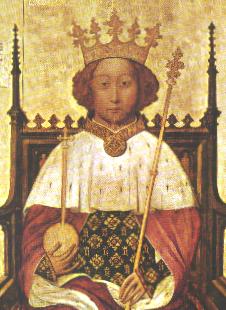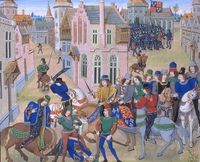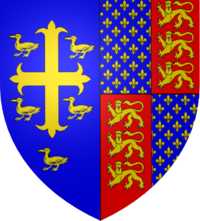Richard II of England
2007 Schools Wikipedia Selection. Related subjects: British History 1500 and before (including Roman Britain); Monarchs of Great Britain
| Richard II | ||
|---|---|---|
| By the Grace of God, King of England and France and Lord of Ireland |
||
 |
||
| Reign | 22 June 1377 - 29 September 1399 | |
| Coronation | 16 July 1377 | |
| Born | 6 January 1367 | |
| Bordeaux | ||
| Died | February 14, 1400 (aged 33) | |
| Pontefract Castle | ||
| Buried | Westminster | |
| Predecessor | Edward III | |
| Successor | Henry IV | |
| Consort | Anne of Bohemia ( 1366- 1394) Isabella of Valois ( 1389- 1410) |
|
| Issue | Died without posterity | |
| Royal House | Plantagenet | |
| Father | Edward, the Black Prince ( 1330- 1376) |
|
| Mother | Joan of Kent ( 1328- 1385) | |
Richard II ( 6 January 1367 – 14 February 1400) was the son of Edward the Black Prince, Prince of Wales, and Joan "The Fair Maid of Kent". He was born in Bordeaux and became his father's successor when his elder brother died in infancy. He was deposed in 1399 and died the next year.
Early life
Because Richard was born at Epiphany and three kings were present at his birth, a legend arose that despite being a second son, he was destined for great things. Certainly he became heir to the throne of England, and was created Prince of Wales, when the Black Prince died after a wasting illness in 1376. The following year his grandfather King Edward III of England also died, making Richard king at the age of ten.
During his minority, three 'continual councils' lasting from June 1377 to January 1380 were responsible for the general governing of the country. In reality John of Gaunt, his uncle, exerted considerable influence on matters of importance (despite not being a member of any of the three councils) especially with regard to foreign policy. During that time, the Peasants' Revolt of 1381 brought Richard to prominence at the age of fourteen. It fell to him personally to negotiate with Wat Tyler, the other rebel leaders, and their massed armed ranks of several thousand. He promised pardon to the leaders of the rebellion, but this was not honoured - they were arrested and executed. Although it is now generally accepted that Richard was not sympathetic to the rebels' demands, it remains doubtful whether Richard intended the arrest to occur, or if he was forced to go against his word by militant sections of the English nobility. Either way, his tactics had the effect of dispersing the rebel forces from the streets of London back to their homes in the country, thus ending the disorder. The young king had shown great promise; but as he matured into adulthood he revealed an inability to make the deals and compromises essential to fourteenth-century politics and diplomacy, leading eventually to his deposition in 1399.
On 22 January 1383, he married Anne of Bohemia, daughter of Charles IV, Holy Roman Emperor and Elizabeth of Pomerania; but they had no children, and she died on 7 June 1394. Richard is said to have been devoted to her. On 31 October 1396, he married the seven year old Princess Isabella of Valois, daughter of Charles VI of France and Isabeau de Bavière; that marriage was also without issue.
First crisis of 1387-88
| English Royalty |
|---|
| House of Plantagenet |
 Armorial of Plantagenet |
| Edward III |
| Edward, Prince of Wales |
| Lionel, Duke of Clarence |
| John, Duke of Lancaster |
| Edmund, Duke of York |
| Thomas, Duke of Gloucester |
| Joan of England |
| Isabella, Countess of Bedford |
| Grandchildren |
| Richard II |
| Philippa, Countess of Ulster |
| Philippa, Queen of Portugal |
| Elizabeth, Baroness Fanhope and Milbroke |
| Henry IV |
| Katherine, Queen of Castile |
| Edward, Duke of York |
| Richard, Earl of Cambridge |
| Constance of York |
| Anne, Countess of Eu |
| Richard II |
As Richard began to take over the business of government himself, he sidelined many of the established nobles, such as Thomas de Beauchamp, 12th Earl of Warwick, Richard Fitzalan, 11th Earl of Arundel, and Thomas of Woodstock, 1st Duke of Gloucester. Instead he turned to his inner circle of favourites for his council, men such as his beloved Robert de Vere, 9th Earl of Oxford and Michael de la Pole, whom Richard created Earl of Suffolk and made chancellor of England. It is possible that Richard had a homosexual relationship with de Vere; Thomas Walsingham called it 'obscene' and 'not without a degree of improper intimacy' . The nobles he had snubbed formed the head of a group of the disaffected who called themselves the Lords Appellant. The central tenet of their appeal was continued war with France against Richard's policy of peace, an aim that many of them pursued in the interests of personal gain rather than the interests of the nation.
In 1387, the English Parliament, under pressure from the Lords Appellant, demanded that Richard remove his unpopular councillors. When he refused, he was told that since he was still a minor, a Council of Government would rule in his place. Richard had the Earl of Arundel, leader of the Lords Appellant, arrested; but Richard's small army led by de Vere was overpowered by the forces of the Lords Appellant outside Oxford, and Richard was imprisoned in the Tower of London. Subsequently Richard agreed to hold a parliament in order to resolve the Appellants' grievances; the unpopular councillors were forcibly disposed of (eight being executed for treason and the others exiled) in the Merciless Parliament of 1388. Richard was forced to accept new councillors and was temporarily stripped of almost all his authority.
A fragile peace
In the years which followed, Richard appeared to have heeded the lessons of 1387, and he became more cautious in his dealings with the barons. In 1390, a tournament was held to celebrate Richard’s coming of age and the apparent new-found harmony since Richard's uncle John of Gaunt's return from Spain. Richard’s team of knights, The Harts, all wore the identical symbol – a white hart – which Richard had chosen. Richard himself favoured genteel interests like fine food, insisting spoons be used at his court and inventing the handkerchief. He beautified Westminster Hall with a new ceiling and was a keen and cultured patron of the arts, architecture and literature. In this sense, he can be seen as an early example of what was later held up as a model Renaissance prince. But many began to see him as another Edward II, somehow unworthy of his military Plantagenet heritage, given his delicate 'unkingly' tastes. Richard also lacked the thirst for battle of his grandfather: his Scottish campaign in 1385 was not decisive, and he signed a 28-year truce with France in 1396 which was hugely unpopular at home in spite of the dividends that peace brought to the kingdom.
Richard's commitment to peace rather than war can also be seen in his first expedition to Ireland in 1394. He put forward a sensible policy based on the understanding that the Irish rebels were motivated largely by the grievances they had against absentee English landowners and that they were perhaps entitled to some redress in this regard. Those whom he labelled the "wild Irish" - native Irish who had not joined the rebel cause - he treated with kindness and respect.
In spite of his forward-thinking attitude toward culture and the arts, Richard seems to have developed a passionate devotion to the old ideal of the Divine Right of Kings, feeling that he should be unquestioned and unfettered in the way he ran the kingdom. He became a stickler for tradition, insisting on being addressed as ‘majesty’ and ‘highness’ and sitting alone for hours wearing his crown; those addressing him were required to direct their eyes downwards in deference. In The Wilton Diptych he was portrayed alongside the Anglo-Saxon saint-kings St Edmund and Edward the Confessor, which reflected not only his attitude toward his own kingship but his genuine religious devotion.
Second crisis of 1397–99 and Richard's deposition
In 1397 Richard decided to rid himself of the Lords Appellant who were confining his power, on the pretext of an aristocratic plot. Richard had the Earl of Arundel executed and Warwick exiled, while Gloucester died in captivity. Finally able to exert his autocratic authority over the kingdom, he purged all those he saw as not totally committed to him, fulfilling his own idea of becoming God’s chosen prince.
Richard was still childless. The heir to the throne was Roger Mortimer the Earl of March, grandson of Lionel of Antwerp, and after his death in 1398, his seven-year-old son Edmund Mortimer. However, Richard was more concerned with Gaunt's son and heir Henry Bolingbroke, whom he banished for ten years on a spurious pretext in 1399. After Gaunt's death, Richard also confiscated Bolingbroke's lands. Some historians have seen this as an act designed to bring greater harmony to England. Bolingbroke's inheritance was huge, large enough to be seen as a small state within the greater state of England and thus an obvious obstacle on the path of a unified and peaceful England. In any event, Richard was only following the policy of his forebears Henry II and Edward I in seizing the lands of a powerful noble to centralize power in the crown.
At this point Richard left for a campaign in Ireland, allowing Bolingbroke the opportunity to land in Yorkshire with an army provided by the King of France to reclaim his father's lands. Richard's autocratic ways, deeply unpopular with many nobles, facilitated Bolingbroke's gaining control quickly of most of southern and eastern England. Bolingbroke had originally just wanted his inheritance and a reimposition of the power of the Lords Appellant, accepting Richard's right to be king and March's right to succeed him. But by the time Richard finally arrived back on the mainland in Wales, a tide of discontent had swept England. In the King's absence, Bolingbroke, who was generally well-liked, was being urged to take the crown himself.
Richard was captured at Flint Castle in Wales and taken to London, where crowds pelted him with rubbish. He was held in the Tower of London and eventually forced to abdicate. He was brought, on his request, before parliament, where he officially renounced his crown and thirty-three official charges (including ‘vengeful sentences given against lords’) were made against him. He was not permitted to answer the charges. Parliament then accepted Henry Bolingbroke (Henry IV) as the new king.
Richard was placed in Pontefract Castle, and died there in 1400. He is believed to have been killed by starvation (perhaps he refused to take nourishment and starved himself) or otherwise murdered. Richard was dead by 17 February.
Richard's body was displayed in the old St Paul's Cathedral for all to see that he was really dead, and he was then buried in Kings Langley Church. His coffin was badly designed, however, and it proved easy for disrespectful visitors to place their hands through several openings in the coffin and interfere with what was inside. It is said that a schoolboy walked off with Richard's jawbone. Rumours that Richard was still alive persisted well into the reign of Henry V, who decided to have his body moved to its final resting place in Westminster Abbey with much ceremony in 1413.
Richard as a collector
Richard was a keen collector of precious objects. We know about many of these objects because in 1398/9 they were recorded on a treasure roll, and the treasure roll has survived. It is now held at the British National Archives, Kew, London (reference TNA: PRO, E 101/411/9).
The roll lists 1,026 items of treasure, how much each item weighed, and how much it was worth. We learn, for example, that Richard had eleven gold crowns, 157 gold cups, and 320 precious religious objects including bells, chalices and reliquaries.
Each item also has a brief description. The only object listed on the roll that certainly survives is a crown now held in the Schatzkammer der Residenz, Munich, Germany. The roll describes the crown as "…set with eleven sapphires, thirty-three balas rubies, a hundred and thirty-two pearls, thirty-three diamonds, eight of them imitation gems".
Association with Geoffrey Chaucer
Geoffrey Chaucer served as a diplomat and Clerk of The King's Works for Richard II. Their relationship encompassed all of Richard's reign, and was apparently fruitful. In the decade before Chaucer's death, Richard granted him several gifts and annuities, including: twenty pounds a year for life in 1394, and 252 gallons (or, one tun) of wine per year in 1397. Chaucer died on 25 October 1400.
In literature
Richard is the main character in Richard II, a play written by William Shakespeare around 1595.

